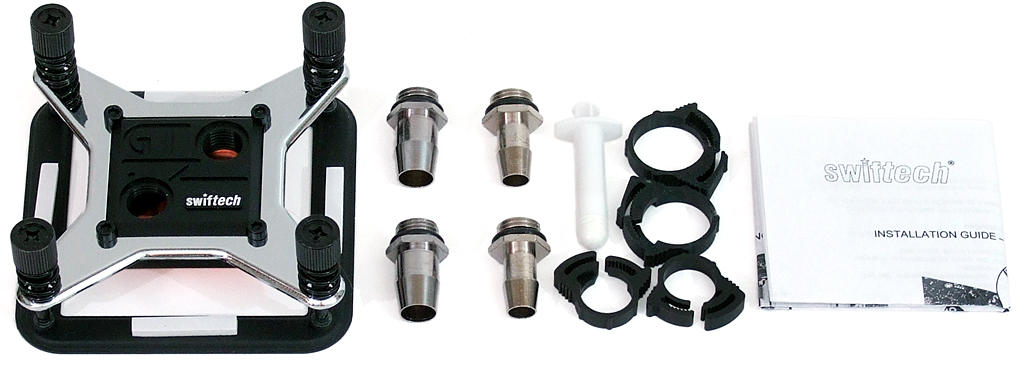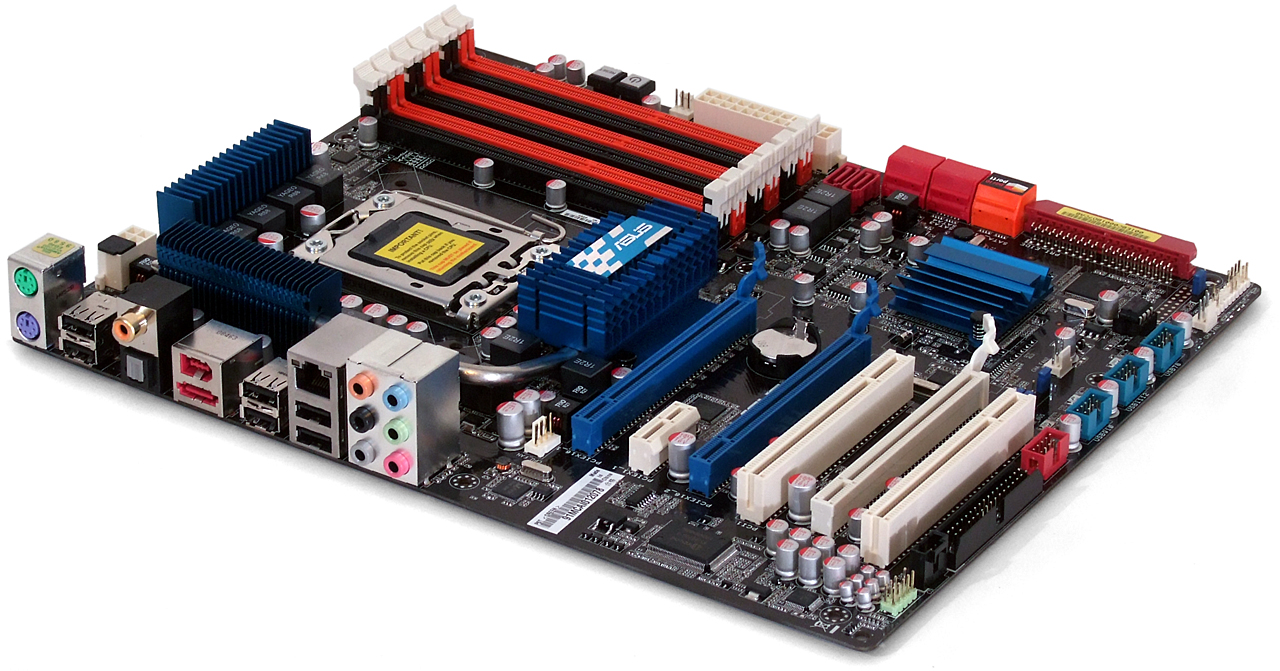Asus And DFI: Core i7 Micro-ATX Motherboards Compared
Test Settings
Though most of our current articles contain updates to both hardware and software, a previous test configuration was required to make today’s benchmark results consistent with those of our other X58 motherboard comparisons.
| Test System Configuration | |
|---|---|
| CPU | Intel Core i7 920 (2.66 GHz, 8.0 MB Cache) |
| CPU Cooler | Swiftech Apogee GTZ Liquid Cooling |
| RAM | Kingston KHX16000D3ULT1K3/6GX (6.0 GB) DDR3-2000 at DDR3-1866 CAS 7-8-7-20 |
| Graphics | XFX GeForce GTX 285 XXX Edition 670MHz GPU, GDDR3-2500 |
| Hard Drive | Western Digital WD5000AAKS, 500 GB 7,200 RPM, SATA 3 Gb/s, 16 MB cache |
| Sound | Integrated HD Audio |
| Network | Integrated Gigabit Networking |
| Power | Coolermaster RS850-EMBA 850W, ATX12V v2.2, EPS12V |
| Software | |
| OS | Microsoft Windows Vista Ultimate x64 SP1 |
| Graphics | Nvidia GeForce 181.20 WHQL |
| Chipset | Intel INF 9.1.0.1007 |
While other reviewers have standardized their tests using DDR3-1600 CAS 8 memory, faster modules are required to assess the full overclocking capabilities of X58 motherboards. Kingston’s DDR3-2000 was chosen for its win in our 6 GB DDR3 overclocking shootout.
Zalman’s ZM-STF1 thermal grease was chosen for its quick set-in time, low thermal resistance, and mess-free application.
Excellent cooling is required to reach our Core i7 920’s overclocking limit. Swiftech’s Apogee GTZ moves heat quickly away from the CPU, via its MCP-655b high-volume pump and 3x120mm radiator.
Top benchmark performance in our previous X58 Motherboard Shootout has made the Asus P6T the reference platform for most of our tests. Today it represents the “Full ATX standard” by which we can judge the effectiveness of micro-ATX alternatives.
| Benchmark Configuration | |
|---|---|
| 3D Games | |
| Call of Duty: World at War | Patch 1.1, FRAPS/saved game High Textures, No AA / No AF, vsync off Ultra Textures, 4x AA / Max AF, vsync off |
| Crysis | Patch 1.2.1, DirectX 10, 64-bit executable, benchmark tool Test Set 1: High Quality, No AA Test Set 2: Very High Quality, 8x AA |
| Far Cry 2 | DirectX 10, Steam Version, in-game benchmark Test Set 1: High Quality, No AA Test Set 2: Ultra High Quality, 8x AA |
| World in Conflict | Patch 1009, DirectX 10, timedemo Test 1: High Details, No AA / No AF Test 2: Very HighDetails 4x AA / 16x AF |
| Audio/Video Encoding | |
| iTunes | Version: 7.7.0.43 Audio CD (Terminator II SE), 53 min Default format AAC |
| Lame MP3 | Version: 3.98 Beta 3 (05-22-2007) Audio CD "Terminator II SE", 53 min wave to MP3 |
| TMPGEnc 4.5 | Version: 4.5.1.254 Import File: Terminator 2 SE DVD (5 Minutes) Resolution: 720x576 (PAL) 16:9 |
| DivX 6.8.3 | Encoding mode: Insane Quality Enhanced multithreading enabled using SSE4 Quarter-pixel search |
| Xvid 1.1.3 | Display encoding status = off |
| MainConcept Reference 1.5.1 | MPEG2 to MPEG2 (H.264), MainConcept H.264/AVC Codec, 28 sec HDTV 1920x1080 (MPEG2), Audio: MPEG2 (44.1 kHz, 2 Channel, 16-Bit, 224 kbp/s), Mode: PAL (25 FPS) |
| Productivity | |
| Autodesk 3ds Max 9 | Version: 9.0, Rendering Dragon Image at 1920x1080 (HDTV) |
| Grisoft AVG Anti-Virus 8 | Version: 8.0.134, Virus base: 270.4.5/1533, Benchmark: Scan 334 MB Folder of ZIP/RAR compressed files |
| WinRAR 3.80 | Version 3.70 BETA 8, WinZIP Commandline Version 2.3, Compression = Best, Dictionary = 4,096 KB, Benchmark: THG-Workload (334 MB) |
| WinZip 11 | Version 11.2, Compression = Best, Benchmark: THG-Workload (139 MB) |
| Sythetic Benchmarks and Settings | |
| 3DMark Vantage | Version: 1.02, GPU and CPU scores |
| PCMark Vantage | Version: 1.00, System, Memory, Hard Disk Drive benchmarks, Windows Media Player 10.00.00.3646 |
| SiSoftware Sandra XII SP2 | Version 2008.5.14.24, CPU Test = CPU Arithmetic / MultiMedia, Memory Test = Bandwidth Benchmark |
Get Tom's Hardware's best news and in-depth reviews, straight to your inbox.
Current page: Test Settings
Prev Page DFI LANParty Jr X58-T3H6 Next Page Benchmark Results: 3D Games-
IzzyCraft Shame the DFI board didn't do better it help shut up people going where is the Rampage II gene in the Builders marathon.Reply
Although this review let me have a little more respect for the board I'm still asus and gigabyte all the way. -
Proximon Really nice article! BIOS screenshots are so important when helping someone configure their board on line, and we do a lot of that around here. I thought you hit all the major points and I especially like the conclusion format.Reply -
andy_mcp1 Great article. About time the facts were laid on the table. I've not quite got to upgrading to I7 M-Atx yet, but got an Asus P5E-VM (not the best admittedly) and an E8400 which on air is oc'd to 4.1Ghz stable (for the past 8 months), which I’ve on countless occasions used to show my mates who have full atx systems that bigger isn’t always better as my 3dmark and pcmark scores were better than theirs (of comparable full sized board builds).Reply
Good point, and I agree, that the hardest thing for the market is for those who have idealisms that the atx board with the most slots are best, have to admit that this not the case, that they don’t need and wont likely use them. It’s about time technology moved on and we start shrinking the components. We've come a long way from house sized computers but seems to have got stuck with fridge-sized atx, time to change that and join the 21st century! -
doomtomb The prices between the DFI and Asus are nearly the same, a difference of $20 or $30. The Asus Rampage II Gene wins it in my opinion.Reply -
SpadeM For me, it's about the features and backplate I/O ports not the performance, when it comes to motherboards with the same chipset. The differences between them is so little that it doesn't matter in real life. Plus given the fat that motherboards, like processors, aren't identical I might get one that performs lower/better then what's in this review.Reply -
Crashman IzzyCraftShame the DFI board didn't do better it help shut up people going where is the Rampage II gene in the Builders marathon.Although this review let me have a little more respect for the board I'm still asus and gigabyte all the way.Reply
Really, the reason the Rampage II Gene wasn't considered for the $2500 PC is that it didn't show up under a Newegg category search (LGA-1366, Micro ATX) and Newegg didn't fix that until this week. It's a good board, and if you need a weird cooler style, supports the more popular LGA-775 coolers. -
atamanroman I like it that uatx is getting more and more attention, since my own i7 uatx cube project is only a few weeks away.Reply
but im missing the MSI X58M (160€ best prive vs 198€ asus and 190 dfi) here, theres a great review at anandtech. the board really rocks and has only a few weak points (fan control and s3 wake up problem if overclocked). i think ppl would be glad if the msi could be added to this comparison.
best regards,
roman -
zehpavora Very good article, but I think that the components chosen should be from the same time frame, because I think that the P6T is "too old" compared to the GENE board. Maybe the P6T V2 would be a better idea. Now I fear the Mini-ATXs.Reply -
avatar_raq Nice article..I wonder if you were planning on it for a while or you wrote it in response to our comments in the SBM..And yeah it showed what I always expect from ASUS; top notch mobos.Reply
P eople go for a full atx build simply because they can (:P), and because larger cases offer better cooling especially for SLI and CF, it's much easier to build and, other than portability, there is no real advantage of a micro-atx build, even the price difference is not worth it in my opinion. But the article does a good job of showing that u-atx boards can be excellent performers. -
Onus Excellent article. Any differences between those boards are molehills, not mountains.Reply
Personally, I'd probably give up a tiny bit of performance for the more noteworthy reduction in power used by DFI; I like the cooler flexibility of the Asus though. It would be a tough call.




